National Historic Sites in Shiga 滋賀の史跡
|
Title   • File Name • File Name   • Date • Date   • Position • Position   |
|

Front view of Anegawa River Battle Memorial where Oda Nobunaga and Tokugawa Ieyasu defeated Azai Nagamasa and the Asakura clan on Aug. 9 1570.
|
|

Statue of Ishida Mitsunari at his former residence in Nagahama.
|
|

Anegawa River ran red with the blood of fallen warriors in Aug. 1570.
|
|

On the other side of this Anegawa River were Oda Nobunaga's forces.
|
|

Wada Tumuli is the group of nine small tumuli in Ritto. 和田古墳群 MAP
|
|

Tumulus No. 5 with a reconstructed chamber made of stone in Ritto.
|
|

The tumuli in Ritto are estimated to have been built during the 6th to 7th centuries.
|
|

Kusatsu-juku Honjin. the Honjin was the town's most luxurious accommodation catering to society's elite like daimyo warlords, Imperial family members including the emperor, and other dignitaries. National Historic SiteAt stage towns along the major roads like the Nakasendo and Tokaido, the Honjin was the town's most luxurious accommodation catering to society's elite like daimyo warlords, Imperial family members including the emperor, and other dignitaries. It operated during 1635 to 1870. The Honjin is now a museum.
This Honjin in Kusatsu is a very impressive example of traditional architecture. It is designated as a National Historical Place. It underwent a complete renovation and reconstruction during 1989 to 1995. (In case you wonder why such an old building looks so new.) Admission 200 yen. 10-min. walk from Kusatsu Station.
|
|

Water intake for Lake Biwa Canal No. 2. The canal is covered. The water supply for Kyoto and Osaka.
|
|

Biwako Sosui. The city of Otsu is thinking about resurrecting a tourist boat service on this canal. MAP
|
|
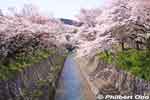
Lake Biwa Canal (Biwako Sosui) and cherry blossoms. This is one of two canals which supply water from Lake Biwa to Kyoto. National Historic Site
|
|

No. 1 Tunnel entrance. The first and longest tunnel under a mountain. The entrance is very artistic.
|
|

Jodan no Ma - Kusatsu-juku Honjin. The Gyokuza raised tatami mats was where the lord or Emperor slept or sat. 上段の間Reserved for daimyo warlords, emperors, etc.
|
|

Site of Hachiman-yama Castle in Omi-Hachiman.
|
|
|

At Ishiyama-dera, inside Room of Genji is a lifesize doll of Lady Murasaki Shikibu who wrote Tale of Genji, one of Japan's most famous novels.
|
|

Lady Murasaki supposedly wrote the novel in this room at Ishiyama-dera in Otsu.
|
|

Stone foundation of original Nagahama castle tower. It is just slightly behind the current castle building is this small hill with stone walls.
|
|

Dotaku Museum in Yasu, Shiga Prefecture. Opened in Nov. 1988, the museum is near the site where Japan's largest bronze bell was unearthed. It has bronze bell exhibits and research facilities. Open 9 am to 5 pm (closed Mon.). Admission 400 yen.
|
|

On Aug. 20, 1881, two young lads were playing on Mt. Oiwa when they stumbled across three dotaku partially exposed in the ground. The next day, eleven more dotaku were discovered in the same area.
|
|

The dotaku were nestled inside each other. These bells are dated from around 100 BC to 300 AD. The bells were not really used as bells. They were more for decorative and religious purposes.
|
|

Monument marking the site where the dotaku were found. It's frustrating that none of the original dotaku discovered in Yasu are in Yasu. Another case of bungling and ineptness by local officials. Even one original dotaku would make the museum busier.
|
|

Adjacent to the Dotaku Museum is a replica of a Yayoi Period village. Yayoi Period (500 BC to 300 AD) is noted as when rice growing started in Japan.
|
|

Basho Matsuo's grave at Gichuji temple, Otsu. 芭蕉の墓
|
|

Basho Matsuo's grave at Gichuji temple, Otsu. 芭蕉の墓
|
|

Hiyoshi Taisha's Nishi Hongu Honden Hall, a National Treasure. It is only one of three buildings in Japan which represent the Hie-zukuri (日吉造り) architectural style. Higashi Hongu and Usagu and the two other shrines in this style.西本宮 �
|
|

Hiyoshi Taisha's Sanno Torii rear view.
|
|

Hiyoshi Taisha's Higashi Hongu Shrine Honden, a National Treasure. This shrine worships the mountain god (Oyamakui-no-kami) of Mt. Hiei. Built in 1595. 東本宮 本殿 国宝
|
|

Located in Higashi-Omi and established by Shotoku Taishi in 609, Hyakusaiji temple is Shiga Prefecture's oldest temple and one of Japan's oldest. It belongs to the Tendai Buddhist Sect. MapThe temple's terraced slope had many temple residences for hundreds of monks training here. National Historic Site
|
|

Autumn leaves. In its heyday, Hyakusaiji was home to 1,300 priests, before the temple was burned by Oda Nobunaga.
|
|

Hyakusaiji's Niomon Gate with giant straw sandals
|
|

Hyakusaiji's Main temple hall (hondo). Important Cultural Property.
|
|

To Mt. Azuchi where Azuchi Castle once stood in Omi-Hachiman. If you don't have a car, rent a bicycle at Azuchi Station (or ride a taxi). The castle site is not very far from Azuchi Station by bicycle.
|
|

A lot of impressive stone work remains of Azuchi Castle.
|
|

Site of Hashiba Hideyoshi's quarters at Azuchi Castle.
|
|

Azuchi Castle tower foundation stones still remain.
|
|

Azuchi Castle tower replica at House of Nobunaga. Very ornate and beautiful. both outside and inside.
|
|

This Azuchi Castle tower replica was displayed in the Japan Pavilion at the Seville Expo '92 in Spain before it was moved here.
|
|

The unique hexagonal base of the upper section of the Azuchi Castle donjon.
|
|
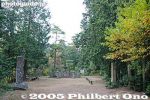
Kitabatake Tomoyuki-kyo Grave 北畠具行卿墓
|
|
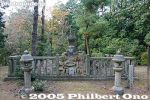
Kitabatake Tomoyuki-kyo Grave. Kitabatake Tomoyuki (1290-1332) was a high-ranking Imperial Court official during the late Kamakura Period. National Historic Site 北畠具行卿墓
|
|

Graves of the Tadotsu Clan (多度津藩), a branch of the Kyogoku who ruled in Marugame. From left to right, Kyogoku Takateru (高琢), Takakata (高賢), Takabumi (高文), Takayoshi (高慶), and Takamichi (高通). National Historic Site
|
|
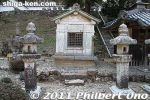
Kyogoku Takatsugu's grave.
|
|
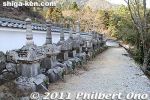
There are steps to go up the hill where there are more Kyogoku graves. These are for the older Kyogoku members, starting with the founder of the Kyogoku Clan.
|
|

This is the hill where the Minakuchi-Okayama Castle was originally built in 1585 by Nakamura Kazuuji 中村一氏, a vassal of Toyotomi Hideyoshi. It fell into ruin after the Battle of Sekigahara where the castle lord lost.
|
|

Nakae Toju's gravestone (left) in Adogawa, Takashima. 藤樹先生墓所
|
|

Koka Ninja House (Koka-ryu Ninjutsu Yashiki) is the former residence of Mochizuki Izumonokami, the leading Koga ninja family of the 53 Koka ninja families. 望月出雲守 MAPThe house is in its original location in the Koka area of Shiga Prefecture.
|
|

The Ninja House, built in 1703, is owned and maintained by a local medicine company having ninja roots. Many Koka ninja were makers of medicine as a front for their clandestine activities. This background also made them expert at making gunpowder.Not a National Historic Site, but it should be.
|
|

Real ninja shuriken throwing star knives on display. Made of steel, they come in many different shapes.
|
|

Toju Shoin Study (drawing room) where Toju lived and taught. Reconstruction of the original building which burned down. 藤樹書院
|
|

Toju Shoin Study (drawing room). 藤樹書院
|
|

Inside Toju Shoin Study (drawing room). 藤樹書院
|
|

Map of Mt. Odani and Odani Castle (National Historic Site). There is a series of castle keeps (maru) along the mountain ridge. Odani Castle was thus a yamajiro or mountain castle.
|
|
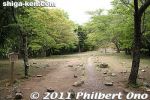
O-hiroma is Odani Castle's largest bailey. The site of a large hall where Azai Nagamasa and Ichi held their wedding. See the illustration. On the far end is the Honmaru.
|
|
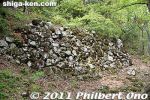
What's left of the large stone wall. It was 5 meters tall and the largest stone wall at Odani Castle, even larger than the Honmaru's stone wall.
|
|
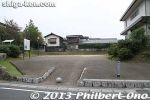
Along the way from Omi Jingu-mae Station to Omi Jingu Shrine, there are two sites of the old Omi-Otsu Palace built when Japan's capital was located here in 667. 近江大津宮錦織遺跡 MAP
|
|
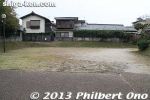
National Historic Site of Omi-Otsu Palace building in Nishikori. Thirteen large pillar holes of a long building was first discovered here in 1974. Otsu was Japan's capital for only 5 years from 667. 近江大津宮
|
|
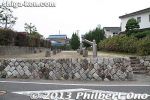
Near the first Otsu Palace site is this second site of the Otsu Palace's main building when Otsu was Japan's capital for 5 years from 667. Now an open space. 近江大津宮錦織遺跡
|
|
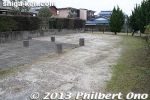
Second site of the Otsu Palace at Nishikori. MAP
|
|
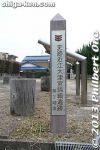
Second site of the Otsu Palace at Nishikori is a National Historic Site called Omi-Otsu-no-Miya Nishikori Iseki.
|
|
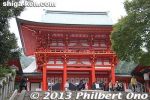
Omi Jingu Shrine's Rōmon Gate (楼門)
|
|

Marker for the Battle of Shizugatake and the famous "Seven Spears" which refer to Hideyoshi's top generals in the battle.
|
|

Samurai statue on Mt. Shizugatake
|
|

Saikyoji is noted for the grave of Akechi Mitsuhide, the lord of Sakamoto Castle and temple patron who helped to reconstruct the temple.
|
|

Grounds of Sakamoto Castle site (Honmaru) on the lake shore.
|
|

Statue of Akechi Mitsuhide at Sakamoto Castle site.
|
|
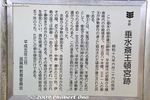
About Tarumi Tongu. (垂水頓宮) Tongu means temporary palace. There were five of them for the Saio princess between Kyoto and the Saiku palace in Ise.
|
|

Only the location of the Tarumi Tongu in Tsuchiyama is known today. The exact locations of the other Tongu palaces are unknown, but two others were in Shiga, called the Seta (勢多) and Kafuka (鹿深) Tongu.
|
|

National Historic Site of Tarumi Tongu. From 886 to 1264 (378 years), a total of 31 Saio princesses lodged at Tarumi Tongu. 垂水頓宮 In 1935, the Japanese government sent a team of scholars to Tarumi and they found solid evidence of the Tarumi Tongu beg located here. Remains of the palace's earthen walls and wells were found in this area. In 1944, this area designated as a National Historic Site.
|
|

Entrance to Tarumi Tongu. The five Tongu palaces were built anew for each Saio procession and then dismantled after the procession was completed. Therefore, there is no remains of the palaces, making it difficult to pinpoint the exact location.
|
|

Shigaraki-no-miya Palace ruins. National Historic Site MAP
|
|

Kyoto-based Emperor Shomu first built a Detached Palace in Shigaraki in 742. This became the the Shigaraki-no-miya Palace.
|
|
|
|
|
|
|
|
|